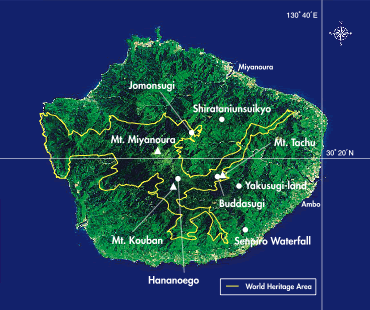
Yakushima is a round-shaped island situated approximately 60 km south from the southern end of the Osumi Peninsula in the southern part of Kagoshima prefecture. One fifth of the island is registered as a World Natural Heritage Site of Natural Beauty. Yakushima gained World Heritage status in 1993. The World Heritage boundaries cover the center of the island and include the highest peaks on the island. There are 3 prongs extending to the east, south and west, but only the latter reaches down to the coastline (the Seibu Rindo Forest Path – 西部林道). The land designated for World Heritage protection also lies within the boundaries of the Yakushima National Park. The Yakushima National Park is a larger area than the World Heritage area and it includes most of the center of the island. The management of the World Heriage area falls to the 3 organizations – National Parks Department, Forestry Department and the local government.
Yakushima exhibits a rich flora, with some 1,900 species and subspecies, including ancient specimens of the sugi (cryptomeria japonica). 94 of these floral species are endemic. More than 200 of these species are at their southern latitude limit and many are at their northern latitude limit. Yakushima also contains remnants of a warm-temperate ancient forest that is unique in this region.
Yakushima’s conservation value is reflected in the 200 plant species which have the southern limit of their natural distribution on the island. The altitudinal continuum of the forests across some 2,000m is considered to be not only the best in the Japanese archipelago, but the best remaining example in East Asia. Ancient yaku sugi trees are of prime conservation value to the island. Sugi trees become yaku sugi when they are deemed to be 1,000 year old or more. Sugi under 1,000 years old are called ‘kosugi`. However, this definition is rather too simplistic as some sugi are deemed to be yaku sugi when they are younger than 1,000 years old. Yaku sugi are generally found between 600m – 1,600m.
There are as many as 6 mountain peaks over 1,800m high including Miyanouradake (1,935m above sea level) – the highest mountain in Kyushu.
The fauna of the island is diverse, including 16 mammal species. Four mammal sub-species, including Yakushima macaque and Yakushima deer, are endemic to the island. A further four sub-species are endemic to both Yakushima and the neighbouring island of Tanegashima. Among the 150 bird species present there are four, including the Ryukyu robin and the Japanese wood pigeon that are designated as Natural Monuments.
The Yakushima World Heritage Nomination is actually a surprisingly brief document. Yakushima World Heritage Nomination Summary (PDF)
We should point out that since receiving World Heritage status there have been, and continue to be, a number of strains imposed upon the island. While the island’s forests are in a better condition then they may have been since the industrial logging began 400 years ago, there are aspects of the island’s rich heritage that have witnessed a detrimental effect since the World Heritage recognition. Since 1993 there has been a dramatic increase in the number of visitors to Yakushima and inevitably they have caused both an environmental stress upon the island as well as largely being unaware that their presence in the mountains slowly erodes away the cultural significance the highland has always held for the inhabitants of Yakushima. For visitors wishing to know more about these issues then we highly recommend booking a YES Tour so that the YES guide can offer you a far better understanding of the island during your visit to Yakushima.


